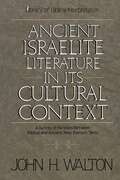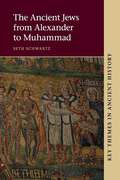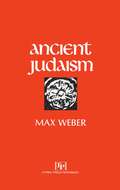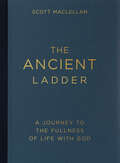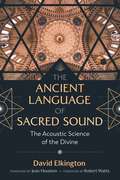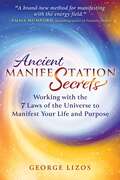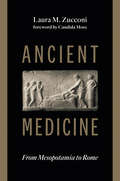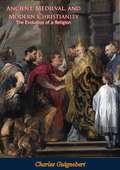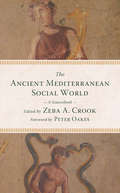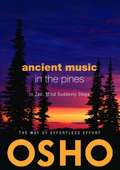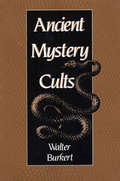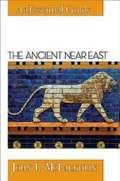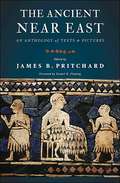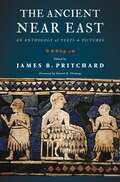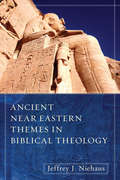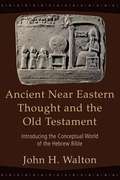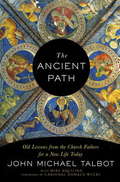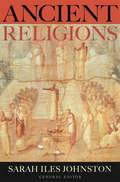- Table View
- List View
Ancient Israel: A Translation with Commentary
by Robert AlterRobert Alter's award-winning translation of the Hebrew Bible continues with the stirring narrative of Israel's ancient history. To read the books of the Former Prophets in this riveting Robert Alter translation is to discover an entertaining amalgam of hair-raising action and high literary achievement. Samson, the vigilante superhero of Judges, slaughters thousands of Philistines with the jawbone of a donkey. David, the Machiavellian prince of Samuel and Kings, is one of the great literary figures of antiquity. A ruthless monarch, David embodies a life in full dimension as it moves from brilliant youth through vigorous prime to failing old age. Samson and David play emblematic roles in the rise and fall of ancient Israel, a nation beset by internal divisions and external threats. A scattering of contentious desert tribes joined by faith in a special covenant with God, Israel emerges through the bloody massacres of Canaanite populations recounted in Joshua and the anarchic violence of Judges. The resourceful David consolidates national power, but it is power rooted in conspiracy, and David dies bitterly isolated in his court, surrounded by enemies. His successor, Solomon, maintains national unity through his legendary wisdom, wealth, and grand public vision, but after his death Israel succumbs to internal discord and foreign conquest. Near its end, the saga of ancient Israel returns to the supernatural. In Elijah's fiery ascent to heaven many would find the harbinger of a messiah coming to save his people in their time of need.
Ancient Israelite Literature in its Cultural Context
by John H. WaltonThis unique book surveys within the various literary genres the parallels between the Bible and the literature of the ancient Near East. Each section begins with a survey of the available ancient literature, continues with a discussion of the literature, and concludes with a discussion of cases of alleged borrowing. The genres covered are - cosmology - laws - historical literature - wisdom literature - apocalyptic literature - personal archives and epics - covenants and treaties - hymns, prayers, and incantations - prophetic literature
Ancient Jewish Sciences and the History of Knowledge in Second Temple Literature (ISAW Monographs #3)
by Seth L. SandersUntil very recently, the idea of ancient Jewish sciences would have been considered unacceptable. Since the 1990s, Early Modern and Medieval Science in Jewish sources has been actively studied, but the consensus was that no real scientific themes could be found in earlier Judaism. This work points them out in detail and posits a new field of research: the scientific activity evident in the Dead Sea Scrolls and early Jewish pseudepigrapha. The publication of new texts and new analyses of older ones reveals crucial elements that are best illuminated by the history of science, and may have interesting consequences for it. The contributors evaluate these texts in relation to astronomy, astrology, and physiognomy, marking the first comprehensive attempt to accountfor scientific themes in Second Temple Judaism. They investigate the meaning and purpose of scientific explorations in an apocalyptic setting. An appreciation of these topics paves the way to a renewed understanding of the scientific fragments scattered throughout rabbinic literature.The book first places the Jewish material in the ancient context of the Near Eastern and Hellenistic worlds. While the Jewish texts were not on the cutting edge of scientific discovery, they find a meaningful place in the history of science, between Babylonia and Egypt, in the time period between Hipparchus and Ptolemy. Thebook uses recent advances in method to examine the contacts and networks of Jewish scholars in their ancient setting. Second, the essays here tackle the problematic concept of a national scientific tradition. Although science is nowadays often conceived as universal, the historiography of ancient Jewish sciences demonstratesthe importance of seeing the development of science in a local context. The book explores the tension between the hegemony of central scientific traditions and local scientific enterprises, showing the relevance of ancient data to contemporary postcolonial historiography of science. Finally, philosophical questions of the demarcation of science are addressed in a way that can advance the discussion of related ancient materials.Online edition available as part of the NYU Library's Ancient World Digital Library and in partnership with the Institute for the Study of the Ancient World (ISAW).
The Ancient Jewish Wedding... and the Return of Messiah for His Bride
by Jamie LashLearn about the Ancient Jewish Wedding and begin preparing for the Marriage Supper of the Lamb! The God of Abraham, Isaac, and Jacob followed the bridal customs of ancient Israel in seeking a bride for His Son, Yeshua. From the selection of the bride and the bride price, to the marriage supper, this teaching by Jamie Lash will thrill your heart and reveal God's love to you in a special way. He wants to bless you with: a Messianic Jewish perspective on "the bride", a bridal anointing, an understanding of God's plan for His people Israel, and an openness to receive gifts from your Heavenly Bridegroom.
The Ancient Jews from Alexander to Muhammad (Key Themes in Ancient History)
by Seth SchwartzThis provocative new history of Palestinian Jewish society in antiquity marks the first comprehensive effort to gauge the effects of imperial domination on this people. Probing more than eight centuries of Persian, Greek, and Roman rule, Seth Schwartz reaches some startling conclusions--foremost among them that the Christianization of the Roman Empire generated the most fundamental features of medieval and modern Jewish life. Schwartz begins by arguing that the distinctiveness of Judaism in the Persian, Hellenistic, and early Roman periods was the product of generally prevailing imperial tolerance. From around 70 C. E. to the mid-fourth century, with failed revolts and the alluring cultural norms of the High Roman Empire, Judaism all but disintegrated. However, late in the Roman Empire, the Christianized state played a decisive role in ''re-Judaizing'' the Jews. The state gradually excluded them from society while supporting their leaders and recognizing their local communities. It was thus in Late Antiquity that the synagogue-centered community became prevalent among the Jews, that there re-emerged a distinctively Jewish art and literature--laying the foundations for Judaism as we know it today. Through masterful scholarship set in rich detail, this book challenges traditional views rooted in romantic notions about Jewish fortitude. Integrating material relics and literature while setting the Jews in their eastern Mediterranean context, it addresses the complex and varied consequences of imperialism on this vast period of Jewish history more ambitiously than ever before. Imperialism in Jewish Society will be widely read and much debated.
Ancient Judaism
by Max WeberWeber’s classic study which deals specifically with: Types of Asceticism and the Significance of Ancient Judaism, History and Social Organization of Ancient Palestine, Political Organization and Religious Ideas in the Time of the Confederacy and the Early Kings, Political Decline, Religious Conflict and Biblical Prophecy.
The Ancient Ladder: A Journey to the Fullness of Life with God
by Scott MacLellanFor all of us longing to find purpose beyond suffering and faith beyond despair, The Ancient Ladder explores the biblically based three-step spiritual passage that ancient mystics saw as the way to follow Jesus toward Christian maturity. What causes faith to transform from an intellectual knowing about God to a passionate love story with God? Scott MacLellan asked this question as his daughter battled cancer and he looked for purpose in his family&’s suffering. He couldn&’t believe that God was uninterested, but he also rejected trite reassurances. He finally found a satisfying answer in the three-step passage—based on the writings of Solomon—that Christian mystics identified as a path through pain to true spiritual devotion. In The Ancient Ladder, Scott helps us apply the wisdom of past centuries to our challenges today as we: Move through Proverbs (fearing the Lord) to Ecclesiastes (honoring the Lord) to Song of Solomon (loving the Lord). Journey from stale spirituality to a robust and meaningful faith that enriches our relationships, self-awareness, and enjoyment of God. See with fresh eyes the big picture of the Christian life. Scott helps us understand Solomon&’s writings, the spiritual fruit that can come from our suffering, and our seasons of unbelief so we can let go of the people we were and become who we were meant to be.
The Ancient Language of Sacred Sound: The Acoustic Science of the Divine
by David Elkington• Details how sacred sites resonate at the same frequencies as both the Earth and the alpha waves of the human brain • Shows how human writing in its original hieroglyphic form was a direct response to the divine sound patterns of sacred sites • Explains how ancient hero myths from around the world relate to divine acoustic science and formed the source of religion The Earth resonates at an extremely low frequency. Known as &“the Schumann Resonance,&” this natural rhythm of the Earth precisely corresponds with the human brain&’s alpha wave frequencies--the frequency at which we enter into and come out of sleep as well as the frequency of deep meditation, inspiration, and problem solving. Sound experiments reveal that sacred sites and structures like stupas, pyramids, and cathedrals also resonate at these special frequencies when activated by chanting and singing. Did our ancestors build their sacred sites according to the rhythms of the Earth? Exploring the acoustic connections between the Earth, the human brain, and sacred spaces, David Elkington shows how humanity maintained a direct line of communication with Mother Earth and the Divine through the construction of sacred sites, such as Stonehenge, Newgrange, Machu Picchu, Chartres Cathedral, and the pyramids of both Egypt and Mexico. He reveals how human writing in its original hieroglyphic form was a direct response to the divine sound patterns of sacred sites, showing how, for example, recognizable hieroglyphs appear in sand patterns when the sacred frequencies of the Great Pyramid are activated. Looking at ancient hero legends--those about the bringers of important knowledge or language--Elkington explains how these myths form the source of ancient religion and have a unique mythological resonance, as do the sites associated with them. The author then reveals how religion, including Christianity, is an ancient language of acoustic science given expression by the world&’s sacred sites and shows that power places played a profound role in the development of human civilization.
Ancient Manifestation Secrets: Working with the 7 Laws of the Universe to Manifest Your Life and Purpose
by George Lizos• Draws on ancient Greek and Egyptian wisdom to explain the 7 manifestation laws of the Universe and how to discover which desires align with your higher purpose• Shares a 5-step process for manifesting your desires and a 10-day manifestation challenge for achieving a singular chosen goal• Presents inner work practices for releasing cognitive and emotional blocks and limiting beliefs that hinder your manifestation journeyWho would not want to become a skilled conscious creator of their life? Diving deep into Hermetic philosophy and the initatic text The Kybalion, manifestation expert George Lizos uncovers the intricate energetic processes and Universal laws that underlie effective manifestation work—the law of attraction being only one step on this way.Ancient Manifestation Secrets teaches a revolutionary 5-step method for successfully manifesting your desires by aligning your energetic field with the 7 laws of the Universe. As you incorporate inner work into the manifestation process, you find energetic practices for releasing and transmuting cognitive and emotional blocks and limiting beliefs that might have hindered success up to now. While not all you wish for is able to manifest, you will discover how to discern which desires are aligned with your higher purpose and Universal laws and how to work with this alignment.Based on ancient wisdom and techniques, this practical guide provides a precise plan of action for manifestation, with effective exercises and inspiring examples illustrating each step. Start manifesting consciously today with your personal 10-day challenge!
Ancient Medicine: From Mesopotamia to Rome
by Laura M. ZucconiThis book by Laura Zucconi is an accessible introductory text to the practice and theory of medicine in the ancient world. In contrast to other works that focus heavily on Greece and Rome, Zucconi&’s Ancient Medicine covers a broader geographical and chronological range. The world of medicine in antiquity consisted of a lot more than Hippocrates and Galen.Zucconi applies historical and anthropological methods to examine the medical cultures of not only Mesopotamia, Egypt, Greece, and Rome but also the Levant, the Anatolian Peninsula, and the Iranian Plateau. Devoting special attention to the fundamental relationship between medicine and theology, Zucconi&’s one-volume introduction brings the physicians, patients, procedures, medicines, and ideas of the past to light.
Ancient Medicine: From Mesopotamia to Rome
by Laura M. ZucconiThis book by Laura Zucconi is an accessible introductory text to the practice and theory of medicine in the ancient world. In contrast to other works that focus heavily on Greece and Rome, Zucconi&’s Ancient Medicine covers a broader geographical and chronological range. The world of medicine in antiquity consisted of a lot more than Hippocrates and Galen.Zucconi applies historical and anthropological methods to examine the medical cultures of not only Mesopotamia, Egypt, Greece, and Rome but also the Levant, the Anatolian Peninsula, and the Iranian Plateau. Devoting special attention to the fundamental relationship between medicine and theology, Zucconi&’s one-volume introduction brings the physicians, patients, procedures, medicines, and ideas of the past to light.
Ancient, Medieval, and Modern Christianity: The Evolution of a Religion
by Charles GuignebertChristian scholar Charles Guignebert (1867 - 1939) lectured extensively on Christian history at the Sorbonne, and conducted a 23 year long "seminar" on the New Testament. In this extensive work, Guignebert illuminates the evolution of Christianity over nineteen centuries.
The Ancient Mediterranean Social World: A Sourcebook
by Zeba A. CrookWhat was the ancient world like? Ancient sources tell us a great deal about the cultural patterns and values that prevailed in the Mediterranean of the biblical periods:how they constructed identityhow they exercised control over groups, space, gender, and dresshow they thought of friendshiphow they participated in social and economic exchangehow ritual functioned and how kinship was constructedwhat healing practices, evil eye, and altered states of consciousness tell us about their scienceshow they talked about each other behind their backs, and whyThe Ancient Mediterranean Social World makes the rich social context of the ancient Mediterranean available to readers through succinct introduction of key ideas, thoughtful selection of translated primary sources, and extensive cataloging of relevant primary sources. Zeba Crook brings together leading scholars to write on twenty different topics, from patronage to gender to loyalty to evil eye. Each chapter opens with an introduction to the topic, offers a short list of secondary sources, and an extensive list of primary sources. The passages in each chapter reflect the vast array of sources roughly from Homer to Augustine, including epigraphical, papyrological, literary, historical, philosophical, biblical, and dramatic texts.This authoritative volume serves as a ready reference for the novice and experienced scholar alike.Contributors:Alicia J. Batten, Giovanni B. Bazzana, Agnes Choi, Zeba A. Crook, John W. Daniels Jr., Dennis C. Duling, John H. Elliott, Amy Marie Fisher, Mischa Hooker, Emil A. Kramer, Jason T. Lamoreaux, Dietmar Neufeld, Jerome H. Neyrey, SJ, Douglas E. Oakman, Ronald D. Roberts, Richard L. Rohrbaugh, Colleen Shantz, Gary Stansell, Eric C. Stewart, Erin K. Vearncombe, and Ritva H. Williams.
The Ancient Mediterranean Social World: A Sourcebook
by Zeba A. CrookWhat was the ancient world like? Ancient sources tell us a great deal about the cultural patterns and values that prevailed in the Mediterranean of the biblical periods:how they constructed identityhow they exercised control over groups, space, gender, and dresshow they thought of friendshiphow they participated in social and economic exchangehow ritual functioned and how kinship was constructedwhat healing practices, evil eye, and altered states of consciousness tell us about their scienceshow they talked about each other behind their backs, and whyThe Ancient Mediterranean Social World makes the rich social context of the ancient Mediterranean available to readers through succinct introduction of key ideas, thoughtful selection of translated primary sources, and extensive cataloging of relevant primary sources. Zeba Crook brings together leading scholars to write on twenty different topics, from patronage to gender to loyalty to evil eye. Each chapter opens with an introduction to the topic, offers a short list of secondary sources, and an extensive list of primary sources. The passages in each chapter reflect the vast array of sources roughly from Homer to Augustine, including epigraphical, papyrological, literary, historical, philosophical, biblical, and dramatic texts.This authoritative volume serves as a ready reference for the novice and experienced scholar alike.Contributors:Alicia J. Batten, Giovanni B. Bazzana, Agnes Choi, Zeba A. Crook, John W. Daniels Jr., Dennis C. Duling, John H. Elliott, Amy Marie Fisher, Mischa Hooker, Emil A. Kramer, Jason T. Lamoreaux, Dietmar Neufeld, Jerome H. Neyrey, SJ, Douglas E. Oakman, Ronald D. Roberts, Richard L. Rohrbaugh, Colleen Shantz, Gary Stansell, Eric C. Stewart, Erin K. Vearncombe, and Ritva H. Williams.
Ancient Models of Mind
by Andrea Nightingale David SedleyHow does god think? How, ideally, does a human mind function? Must a gap remain between these two paradigms of rationality? Such questions exercised the greatest ancient philosophers, including those featured in this book: Socrates, Plato, Aristotle, the Stoics and Plotinus. This volume encompasses a series of studies by leading scholars, revisiting key moments of ancient philosophy and highlighting the theme of human and divine rationality in both moral and cognitive psychology. The volume is a tribute to A. A. Long, and reflects multiple themes of his own work.
Ancient Music in the Pines
by Osho Osho International FoundationToday, humanity is caught up in the mad complexity of the mind, and as never before, there is an urgent need to rediscover simplicity and innocence. Osho brings to life the inherent and timeless wisdom of traditional Zen stories. He shows us that Zen is a way of dissolving philosophical problems, not of solving them. It is a way of getting rid of philosophy, because philosophy is a sort of neurosis. Zen is for those intelligent enough to understand the limitations of the intellect and ready to recognize the significance of intuition in the world of mysticism.
Ancient Mystery Cults (Carl Newell Jackson Lectures #1)
by Walter BurkertThe foremost historian of Greek religion provides the first comprehensive, comparative study of a little-known aspect of ancient religious beliefs and practices. Secret mystery cults flourished within the larger culture of the public religion of Greece and Rome for roughly a thousand years. This book is neither a history nor a survey but a comparative phenomenology, concentrating on five major cults. In defining the mysteries and describing their rituals, membership, organization, and dissemination, Walter Burkert displays the remarkable erudition we have come to expect of him; he also shows great sensitivity and sympathy in interpreting the experiences and motivations of the devotees.
Ancient Mystic Oriental Masonry: Its Teachings, Rules, Laws and Present Usages Which Govern the Order at the Present Day
by Dr R. Swinburne Clymer"Ancient Mystic Oriental Masonry: Its Teachings, Rules, Laws and Present Usages Which Govern the Order at the Present Day" by Dr. R. Swinburne Clymer is an in-depth and scholarly exploration of the ancient and mystical traditions of Oriental Masonry. This comprehensive work delves into the rich history, profound teachings, and current practices of this esoteric order, offering readers a detailed understanding of its principles and rituals.Dr. Clymer, a renowned mystic and Masonic scholar, provides a thorough examination of the origins and development of Oriental Masonry, tracing its roots back to ancient civilizations and secret societies. He elucidates the core teachings and philosophies that underpin the order, highlighting their significance in the pursuit of spiritual enlightenment and personal transformation.In this illuminating book, Clymer covers the intricate rules and laws that govern the order, detailing the rituals, symbols, and ceremonies that are integral to its practice. He explores the moral and ethical precepts that guide members, emphasizing the importance of integrity, wisdom, and brotherhood in the Masonic tradition."Ancient Mystic Oriental Masonry" also addresses the contemporary relevance of these ancient teachings, illustrating how they continue to influence and inspire modern practitioners. Through a blend of historical analysis and practical guidance, Clymer provides valuable insights into the mystical and spiritual dimensions of Masonry, making this book an essential resource for both initiates and seasoned members of the order.Dr. Clymer's authoritative and eloquent writing makes complex concepts accessible, while his deep reverence for the subject matter shines through on every page. This book is not only a guide to the rituals and laws of Oriental Masonry but also a profound exploration of its spiritual essence and enduring legacy."Ancient Mystic Oriental Masonry" is a must-read for Masons, historians, and anyone interested in the mystical traditions of the East. Dr. R. Swinburne Clymer's work stands as a testament to the timeless wisdom and transformative power of Oriental Masonry, offering a pathway to deeper understanding and spiritual growth.
The Ancient Near East: An Essential Guide (An Essential Guide)
by John L. MclaughlinThe cultures of the great empires of the ancient Near East from Egypt to Mesopotamia influenced Israel's religion, literature, and laws because of Israel's geographic location and political position situation. Anyone who wishes to understand the Old Testament texts and the history of ancient Israel must become familiar with the history, literature, and society of the surrounding kingdoms that at times controlled the region. Brief in presentation yet broad in scope, Ancient Near East will introduce students to the information and ideas essential to understanding the texts of the Old Testament while clarifying difficult issues concerning the relationship between Israel and its neighbors. Abingdon Essential Guides fulfill the need for brief, substantive, yet highly accessible introductions to the core disciplines in biblical, theological, and religious studies.
The Ancient Near East: An Anthology of Texts and Pictures
by James B. PritchardThis volume provides a stimulating introduction to some of the most significant and widely studied texts of the ancient Near East, including the Epic of Gilgamesh, the Creation Epic (Enuma elish), the Code of Hammurabi, and the Baal Cycle. For students of history, religion, the Bible, archaeology, and anthropology, this anthology provides a wealth of material for understanding the ancient Near East.
The Ancient Near East: An Anthology of Texts and Pictures (Ancient Near East: Classic Studies)
by James B. PritchardJames Pritchard's classic anthologies of the ancient Near East have introduced generations of readers to texts essential for understanding the peoples and cultures of this important region. Now these two enduring works have been combined and integrated into one convenient and richly illustrated volume, with a new foreword that puts the translations in context. With more than 130 reading selections and 300 photographs of ancient art, architecture, and artifacts, this volume provides a stimulating introduction to some of the most significant and widely studied texts of the ancient Near East, including the Epic of Gilgamesh, the Creation Epic (Enuma elish), the Code of Hammurabi, and the Baal Cycle. For students of history, religion, the Bible, archaeology, and anthropology, this anthology provides a wealth of material for understanding the ancient Near East.Represents the diverse cultures and languages of the ancient Near East--Sumerian, Akkadian, Egyptian, Hittite, Ugaritic, Canaanite, and Aramaic--in a wide range of genres: Historical texts Legal texts and treaties Inscriptions Hymns Didactic and wisdom literature Oracles and prophecies Love poetry and other literary texts LettersNew foreword puts the classic translations in contextMore than 300 photographs document ancient art, architecture, and artifacts related to the textsFully indexed
Ancient Near Eastern Themes in Biblical Theology
by Jeffrey J. NiehausAncient Near Eastern Themes in Biblical Theology traces the many parallels between the Old Testament (and Bible as a whole) and the ancient Near East, including creation and flood narratives, common literary and legal forms, supposed acts of deities and the God of the Bible, and more. Instead of merely studying a random selection of parallels, however, Jeffrey Niehaus proposes that they represent “a shared theological structure of ideas in the ancient Near East, a structure that finds its most complete and true form in the Old and New Testaments.” This comprehensive and enlightening resource promises to help students and discerning Bible readers to intellectually grasp and appreciate the overarching story of the Bible within its cultural development.
Ancient Near Eastern Thought And The Old Testament
by John H. WaltonMuch of the Old Testament seems strange to contemporary readers. However, as we begin to understand how ancient people viewed the world, the Old Testament becomes more clearly a book that stands within its ancient context as it also speaks against it. John Walton provides here a thoughtful introduction to the conceptual world of the ancient Near East. Walton surveys the literature of the ancient Near East and introduces the reader to a variety of beliefs about God, religion, and the world. In helpful sidebars, he provides examples of how such studies can bring insight to the interpretation of specific Old Testament passages. Students and pastors who want to deepen their understanding of the Old Testament will find this a helpful and instructive study.
The Ancient Path
by Mike Aquilina John Michael Talbot Cardinal Donald WuerlPeople often imagine that the Church Fathers looked like their icons and smelled of incense, heroic figures wrapped in fine liturgical vestments of silk and lace, engulfed in billows of smoke from their golden censers. Yet, truth be told, even in their writings they resemble more the tattered cloak of Jesus or the dusty sweat-soaked habits of the early Desert Fathers and Mothers. Theirs is an utterly incarnational spirituality. It is heaven-sent, but it moves forward with both feet on the ground of the earth. In this powerful work, John Michael Talbot tells the story of how these men deeply influenced his spiritual, professional and personal life. Coming to the Christian faith as a young man during the turbulent 1960s, he soon grew a fond of the Church Fathers, including St. Ambrose, St. Jerome, St. Augustine and Gregory the Great and found guidance, reassurance and wisdom on his path to Jesus. "The First Epistle of Saint Peter," writes Talbot, "tells us that we are 'a spiritual temple built of living stones.' The early Church Fathers represent the first rows built upon the foundation of the Apostles. And that sacred building project continues throughout history to our time today. But it rests on the Fathers. It depends on them." From the Hardcover edition.
Ancient Religions
by Sarah Iles JohnstonReligious beliefs and practices, which permeated all aspects of life in antiquity, traveled well-worn routes throughout the Mediterranean: itinerant charismatic practitioners journeying from place to place peddled their skills as healers, purifiers, cursers, and initiators; and vessels decorated with illustrations of myths traveled with them. New gods encountered in foreign lands by merchants and conquerors were sometimes taken home to be adapted and adopted. This collection of essays by a distinguished international group of scholars, drawn from the groundbreaking reference work Religion in the Ancient World, offers an expansive, comparative perspective on this complex spiritual world.

